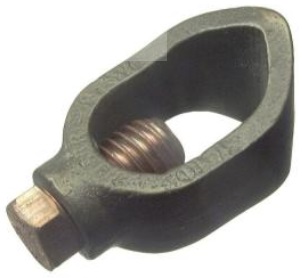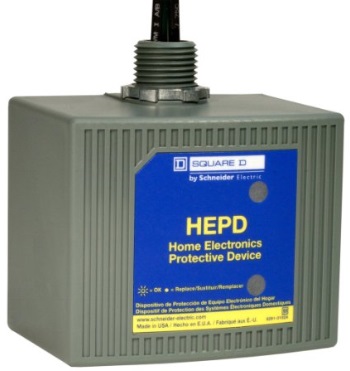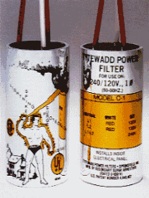Home Site Map - Techniques - Electrical -
Electrical Grounding and Surges
![]() How to ensure your house electrical system is properly protected.
How to ensure your house electrical system is properly protected.
Grounding
Having good grounding for all your electrical panels will protect the electronics in your house and might even save your life. When surge protectors trigger they need to be able to dump excess energy into the ground and you need to get rid of that energy or else the surge protector will not help you.
Rather than just using the two building code specified 6 foot separated metal stakes in the ground it is worth going above a beyond. Using 10 copper clad 8 foot long 5/8" diameter stakes driven into earth (not stones) that rain water will flow to will provide a much better ground. Put the first two stakes close to the panel with about an 8 foot spacing because this will ensure you meet building code. In my case I have two subpanels so I need two stakes for each panel to meet building code. Put the other 8 stakes in an earth swale (shallow ditch to channel ground water flow). Use 6" of gravel in the swale to help water collect. Put the stakes about 10 feet apart and bang them in so that the tops are 6" below the surface (the 6" will be covered by gravel). Connect all the stakes using thick stranded copper wire of at least #4 diameter. Use good quality ground clamps (UL approved for burial) to daisy-chain attach the wire to the stakes.
 Details
are here .
Details
are here .
Keep the wire a continuous piece rather than having any joins. It is best to wrap the wire round the stake and put the clamp over the wrapped wire. Burry the wire between stakes 6" below the surface. If you have a Well then layout the stakes in the direction of the Well and continue the wire on past the stakes to the Well metal casing. This will need something like a total of 150 feet of earth wire because there is a building exclusion area of 100 feet radius around any Well. The metal casing of a Well is a very good earth so it is highly beneficial to connect it into your grounding system. I route the earth wire along the south edge of the driveway in a small swale. In the ditch there are 6 stakes (in addition to the two on the west of the house and the four north of the north house wall just behind the electric panels).
Even though a sub-panel must separately connect the earth back to the earth of the main panel (and the ground in the sub-panel must not be connected to the neutral in the sub-panel), it is still highly desirable to provide a grounding system associated with the sub-panel. Having a good earth close to your actual house (rather than the main panel in your yard) is actually the most important because all your sensitive electronics will mainly be in your house. In my case, the main panel in the yard just has a grounding system that just meets code by having two earth stakes. Associated with the house (ie the house sub-panels) there is a really good "12 stake + Well" grounding system. If the main panel in the yard gets hit by lightning then it may even be that the lowest resistance path to earth will be via the ground wire to the sub-panel and from there to the house grounding system, but that's perfectly ok.
Inside your house you should run a ground wire back to the panel ground for anything large that is metal, eg duct work, garage door runners, etc. To avoid having to run too many ground wires it is best to avoid metal conduit, metal pipes, and metal electrical boxes. Using plastic is a much better choice.
Whole house power surge arrestor
It is highly recommended that you install a whole house power surge arrestor in your main panel and in any sub-panel that feeds electronic equipment.
In a sub-panel, I think it is best use a surge protector that dumps the spike into the earth rather than the neutral. This avoids the spike having to go all the way back to the main panel before getting to earth.
You want a unit that mounts so that you can see the LED indicators. This means you want it mounted on the outside of the electrical panel.
If the product has an earth wire and a neutral wire, you need to make sure the two are not connected because it a sub-panel they must not be connected.
 Details
here .
Details
here .

This will clamp your 120V to stop it exceeding 130V, and clamp your 240V to stop it exceeding 260V. In the case of a large event such as a lightening strike it may sacrifice itself in the process and become a short circuit to trip your breaker. You should install it on an in-use high current dual pole breaker in your panel so that it's obvious to you if the surge arrestor has had to sacrifice itself.
In my case I have one in the 600A main panel but connected the other side of the 200A breaker that feeds the primary sub-panel in the house. It protects all of the 600A circuit but only the 200A breaker will trip if it has to sacrifice itself. I also have another one in the house sub-panel that feeds sensitive electronics. This is connected just after the main sub-panel switch, ie relies on the breaker in the main panel that feeds the sub-panel. If the one in the house sacrifices itself then I will know because none of the lights in the house will work (and the LEDs on the surge protector will not be illuminated).
Subpanels
It is useful to also have a whole house surge protector in each subpanel.
For a surge protector on a subpanel, the white wire from the surge protector should be connected to the EARTH bar rather than the neutral bar.



